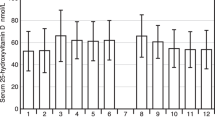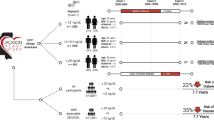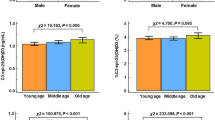Abstract
Classification into month-specific cutpoints is used to minimize misclassification associated with single measurement of serum 25(OH)D. This study aims to evaluate this strategy, and to compare it with the widely used classification into overall cutpoints. For this purpose, we studied 69 553 subjects in whom serum 25(OH)D was tested on two different occasions. The level of agreement between the quartiles of the first and second tests was 43.8% between the month-specific quartiles and 43.1% between the overall quartiles. The level of agreement between the quartiles of the two approaches was 80.0% and 94.3% in the first and second test, respectively. The extent of seasonal variation (summer–autumn as compared with winter–spring) of serum 25(OH)D was higher in males and in Jews, inversely associated with baseline levels, body mass index and age, and directly associated with socioeconomic class. The month-specific cutpoint strategy does not seem to offer advantage over the overall cutpoints strategy.
This is a preview of subscription content, access via your institution
Access options
Subscribe to this journal
Receive 12 print issues and online access
$259.00 per year
only $21.58 per issue
Buy this article
- Purchase on Springer Link
- Instant access to full article PDF
Prices may be subject to local taxes which are calculated during checkout

Similar content being viewed by others
References
Holick MF . Vitamin D deficiency. N Engl J Med 2007; 357: 266–281.
Saliba W, Rennert HS, Kershenbaum A, Rennert G . Serum 25(OH)D concentrations in sunny Israel. Osteoporos Int 2012; 23: 687–694.
Wang Y, Jacobs EJ, McCullough ML, Rodriguez C, Thun MJ, Calle EE et al. Comparing methods for accounting for seasonal variability in a biomarker when only a single sample is available: insights from simulations based on serum 25-hydroxyvitamin d. Am J Epidemiol 2009; 170: 88–94.
Dobnig H, Pilz S, Scharnagl H, Renner W, Seelhorst U, Wellnitz B et al. Independent association of low serum 25-hydroxyvitamin d and 1,25-dihydroxyvitamin d levels with all-cause and cardiovascular mortality. Arch Intern Med 2008; 168: 1340–1349.
Melamed ML, Michos ED, Post W, Astor B . 25-hydroxyvitamin D levels and the risk of mortality in the general population. Arch Intern Med 2008; 168: 1629–1637.
Hutchinson MS, Grimnes G, Joakimsen RM, Figenschau Y, Jorde R . Low serum 25-hydroxyvitamin D levels are associated with increased all-cause mortality risk in a general population: the Tromsø study. Eur J Endocrinol 2010; 162: 935–942.
Li H, Stampfer MJ, Hollis JB, Mucci LA, Gaziano JM, Hunter D et al. A prospective study of plasma vitamin D metabolites, vitamin D receptor polymorphisms, and prostate cancer. PLoS Med 2007; 4: e103.
Shoben AB, Kestenbaum B, Levin G, Hoofnagle AN, Psaty BM, Siscovick DS et al. Seasonal variation in 25-hydroxyvitamin d concentrations in the cardiovascular health study. Am J Epidemiol 2011; 174: 1363–1372.
Bolland MJ, Grey AB, Ames RW, Mason BH, Horne AM, Gamble GD et al. The effects of seasonal variation of 25-hydroxyvitamin D and fat mass on a diagnosis of vitamin D sufficiency. Am J Clin Nutr 2007; 86: 959–964.
Wortsman J, Matsuoka LY, Chen TC, Lu Z, Holick MF . Decreased bioavailability of vitamin D in obesity. Am J Clin Nutr 2000; 72: 690–693.
Author information
Authors and Affiliations
Corresponding author
Ethics declarations
Competing interests
The authors declare no conflict of interest.
Rights and permissions
About this article
Cite this article
Saliba, W., Barnett-Griness, O. & Rennert, G. Single measurement of serum 25(OH)D: is classification into month-specific cutpoints useful in accounting for seasonal variation?. Eur J Clin Nutr 66, 1069–1071 (2012). https://doi.org/10.1038/ejcn.2012.69
Received:
Revised:
Accepted:
Published:
Issue Date:
DOI: https://doi.org/10.1038/ejcn.2012.69



